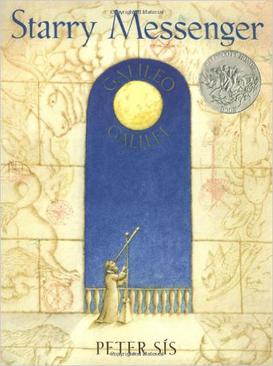Starry Messenger (picture book) facts for kids

First edition
|
|
| Author | Peter Sis |
|---|---|
| Cover artist | Peter Sis |
| Country | United States |
| Language | English |
| Subject | Biography |
| Published | Square Fish; Reprint edition (2000) |
| Pages | 40 p. |
Starry Messenger is a children's picture book from 1996. It was written and illustrated by Peter Sís. This book tells the story of the famous scientist Galileo Galilei. It even won a special award called the Caldecott Honor in 1997! Peter Sis uses his amazing drawings to show different parts of Galileo's life.
Contents
Exploring Galileo's Life: A Book Overview
The book Starry Messenger shares the life story of the brilliant scientist Galileo Galilei. It starts from his birth and follows him through many important events. Peter Sis describes Galileo as a boy "born with stars in his eyes." This idea runs through the whole book. It connects Galileo's childhood, his time as a student, and his later work as a scientist.
The World Before Galileo's Discoveries
The book begins by showing what the world was like in Galileo's time. People believed in the Ptolemaic System. This idea said that Earth was the center of the Solar System. All the planets and the Sun were thought to orbit around our planet.
Galileo's Amazing Discoveries
As Galileo grew, he became a scientist, mathematician, philosopher, and physicist. He made many important observations about space. Peter Sis includes parts of Galileo's own drawings in the book. He also uses quotes from Galileo's real book, also called Starry Messenger. This book shared Galileo's amazing discoveries about the stars and planets.
One of Galileo's most important ideas was the Copernican theory. This theory stated that the Sun, not Earth, was the center of our solar system. This idea was very different from what people believed then.
Challenges and Changes for Galileo
Galileo's new ideas, especially the Copernican theory, caused problems for him. The Vatican Church did not agree with his findings. They believed Earth was the center of the universe.
Galileo was called to face the Church leaders. He was asked to say that his ideas were wrong. If he did not, he could face serious consequences. Galileo chose to take back his statements. After this, he was kept under house arrest for eight years. He passed away in 1642.
A Later Pardon for Galileo
The book ends on a hopeful note. More than 300 years later, in October 1992, Galileo was officially pardoned. This means his name was cleared, and his scientific work was finally recognized.

